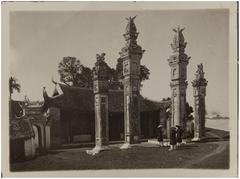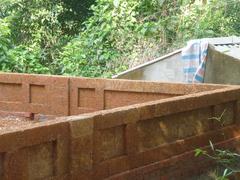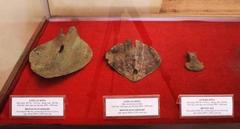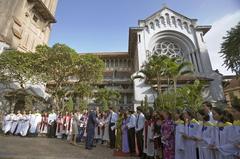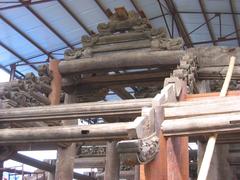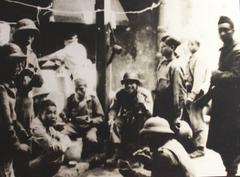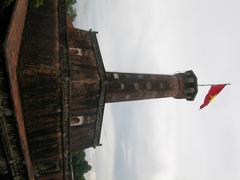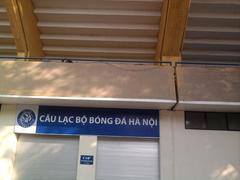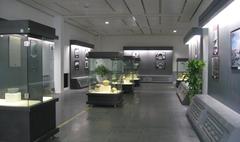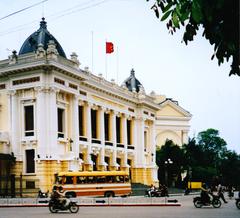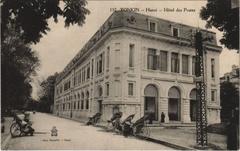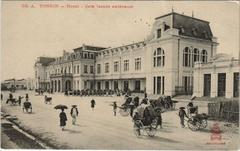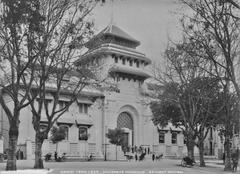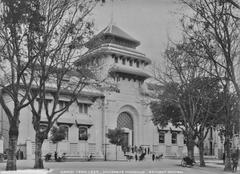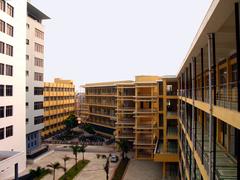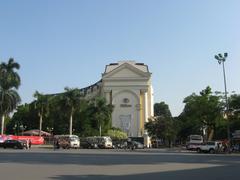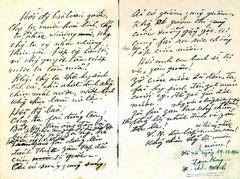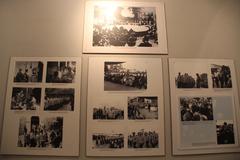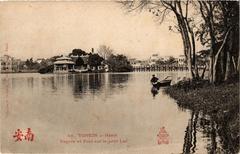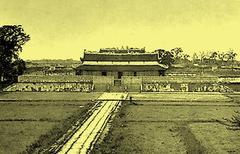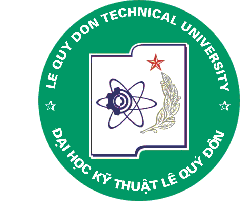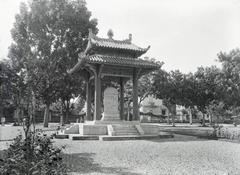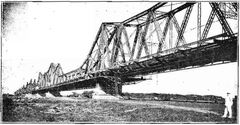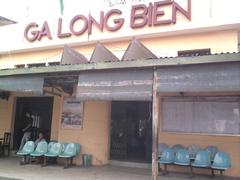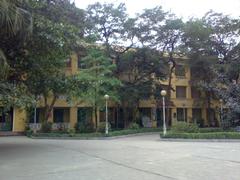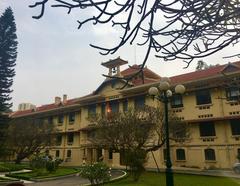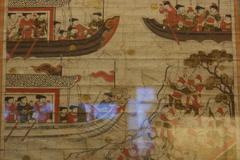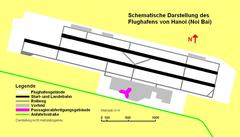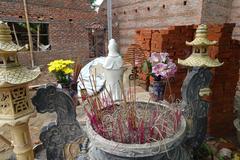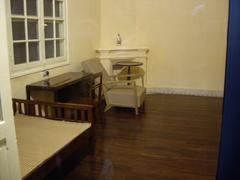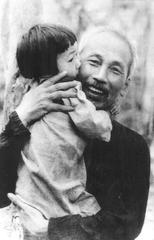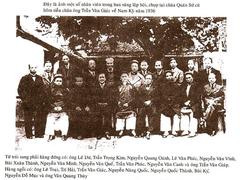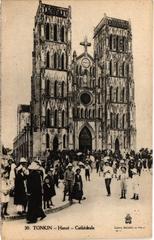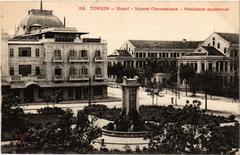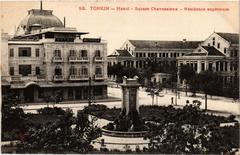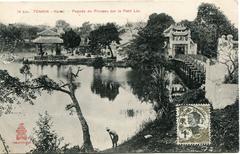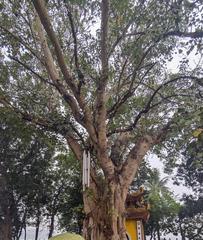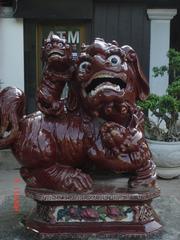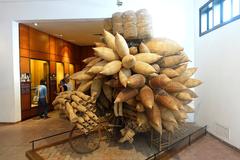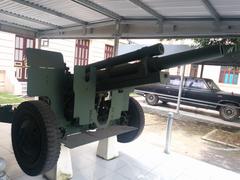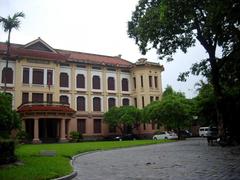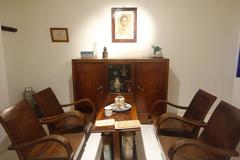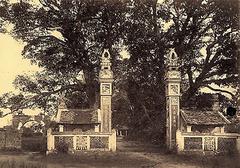
Ngọc Lũ Drum Visiting Hours, Tickets, and Hanoi Historical Sites Guide
Date: 04/07/2025
Introduction
The Ngọc Lũ Drum stands as one of Vietnam’s most esteemed cultural treasures, reflecting the artistic mastery and spiritual depth of the Đông Sơn culture that flourished over 2,000 years ago in northern Vietnam’s Red River Delta. Discovered in 1893 in Ngọc Lũ village, Hà Nam Province, this ancient bronze drum is celebrated for its intricate craftsmanship, detailed iconography, and its enduring significance as a symbol of Vietnamese heritage. Today, it is a highlight exhibit at the Vietnam National Museum of History in Hanoi, drawing visitors and scholars interested in Vietnam’s Bronze Age legacy.
This guide provides a comprehensive overview of the Ngọc Lũ Drum, covering its historical background, artistic features, cultural significance, and practical information for visitors—including opening hours, ticketing, accessibility, and nearby attractions. Whether you are a history enthusiast, art lover, or traveler, this resource will enrich your appreciation of the drum and enhance your visit to one of Hanoi’s premier historical sites.
For more details, consult the Vietnam National Museum of History Official Website, Wikipedia English, and the UN.org cultural heritage documentation.
Table of Contents
- Introduction
- Historical Background
- Physical Characteristics and Artistic Features
- Decorative Motifs and Iconography
- Function and Significance in Đông Sơn Society
- Visiting the Ngọc Lũ Drum: Practical Information
- Nearby Historical Sites in Hanoi
- Frequently Asked Questions (FAQ)
- Conclusion
- References and Further Reading
Historical Background
Discovery and Provenance
The Ngọc Lũ Drum was discovered in 1893 during dike construction efforts in Hà Nam Province, southeast of Hanoi. Unearthed by local workers in Ngọc Lũ village, the drum was initially used in local rituals before being acquired by the École française d’Extrême-Orient and ultimately transferred to Hanoi for preservation and study (Wikipedia Vietnamese; Wikipedia English). Its recovery marked a defining moment in Vietnamese archaeology, providing a tangible connection to the Bronze Age Đông Sơn culture.
Dating and Cultural Context
Archaeological research places the drum’s creation in the 2nd–3rd centuries BCE, the zenith of the Đông Sơn culture—an era marked by advanced bronze casting and rich artistic traditions (Wikipedia English). The widespread distribution of Đông Sơn drums across Vietnam and Southeast Asia underscores the region’s extensive trade networks and cultural influence during this period.
Physical Characteristics and Artistic Features
The Ngọc Lũ Drum is renowned for its size, beauty, and state of preservation. It measures approximately 63 centimeters in height and 79 centimeters in diameter, and weighs around 86 kilograms (Wikipedia Vietnamese; UN.org). Cast as a single piece using the lost-wax technique, the drum is divided into three main sections:
- Tympanum (Drumhead): Overhangs the body slightly and features the most intricate decorations.
- Body: Cylindrical and slightly tapered, adorned with geometric and figurative motifs.
- Base: Provides stability, more simply decorated.
Decorative Motifs and Iconography
The drum’s surface is covered with elaborate designs that reflect Đông Sơn cosmology and daily life:
- Central Sunburst: The drumhead’s center features a starburst motif (often 14 points), symbolizing the sun and the universe.
- Concentric Panels: Surrounding the central motif are registers depicting scenes of processions, rituals, music, agriculture, and boats, as well as animals such as birds and deer—symbols of nature and fertility.
- Geometric Patterns: Zigzags, triangles, and circles, representing water, rice fields, or other cosmological elements, frame the figurative scenes.
The artistic clarity and complexity of these motifs provide invaluable insight into the beliefs, rituals, and social structure of the Đông Sơn people.
Function and Significance in Đông Sơn Society
The Ngọc Lũ Drum served multiple roles in Đông Sơn society:
- Ritual and Ceremonial Object: Used in religious and communal ceremonies, including ancestor worship, agricultural rites, and festivals.
- Musical Instrument: Played during processions and communal gatherings.
- Status Symbol: Its elaborate design suggests it was associated with local leaders or elite classes.
- Burial Good: Some similar drums have been found in tombs, indicating their role in funerary practices.
As the most exquisite example of Đông Sơn drums, the Ngọc Lũ Drum is a symbol of Vietnamese ingenuity and spiritual life (Wikipedia English).
Visiting the Ngọc Lũ Drum: Practical Information
Location
- Vietnam National Museum of History
- Address: 1 Tràng Tiền Street, Hoàn Kiếm District, Hanoi
- Centrally located near the Old Quarter and major Hanoi landmarks
Visiting Hours and Tickets
-
Opening Hours:
Tuesday to Sunday: 8:30 AM – 5:00 PM
Closed Mondays and public holidays -
Ticket Prices:
- Vietnamese adults: 40,000 VND
- Foreign visitors: 60,000 VND
- Students/children: Discounted rates available; check the museum website for details
-
Purchase:
Tickets can be bought at the entrance or via the official museum website.
Accessibility and Facilities
-
Accessibility:
Wheelchair access, ramps, elevators, and accessible restrooms are available. Contact the museum in advance for specific needs. -
Facilities:
Restrooms, a café, and a gift shop are on-site.
Guided Tours and Special Events
- Guided tours: Available in multiple languages by request or with advance booking.
- Special exhibitions and workshops: Check the museum’s calendar for events related to Đông Sơn culture and Vietnamese heritage.
Travel Tips
- Arrive early to avoid crowds and maximize your visit.
- Combine your trip with nearby sites such as the Old Quarter, Hoan Kiem Lake, and the Temple of Literature.
- Use the museum’s online resources, including 3D virtual tours, to prepare for your visit.
- Photography is permitted in most areas without flash; always check signage for restrictions.
Visual Media
Alt text: Ngọc Lũ Drum bronze artifact on display at Vietnam National Museum of History in Hanoi.
For a virtual experience, explore the museum’s online gallery.
Nearby Historical Sites in Hanoi
- Hanoi Old Quarter: Vibrant markets, street life, and colonial architecture.
- Temple of Literature: Vietnam’s first university, steeped in tradition and history.
- Imperial Citadel of Thăng Long: A UNESCO World Heritage Site.
- Hoan Kiem Lake: The spiritual and social heart of Hanoi.
- Hanoi Opera House: A stunning example of French colonial architecture.
These sites are within walking distance or a short taxi ride from the museum, making it easy to explore multiple highlights in one trip.
Frequently Asked Questions (FAQ)
Q: What are the Ngọc Lũ Drum visiting hours?
A: The museum is open Tuesday to Sunday, 8:30 AM to 5:00 PM, and closed on Mondays and public holidays.
Q: How much are tickets to see the Ngọc Lũ Drum?
A: Adults: 40,000 VND (Vietnamese), 60,000 VND (foreigners); discounts for students and children.
Q: Is the museum accessible for visitors with disabilities?
A: Yes, it is equipped with ramps, elevators, and accessible restrooms.
Q: Are guided tours available?
A: Yes, in multiple languages by request or advance booking.
Q: Can I take photos of the drum?
A: Photography is allowed in most areas without flash; check for signage.
Q: What other historical sites are nearby?
A: The Old Quarter, Temple of Literature, Hoan Kiem Lake, and Imperial Citadel of Thăng Long are all nearby.
Conclusion
The Ngọc Lũ Drum is not only a masterpiece of Bronze Age art but also a living symbol of Vietnamese heritage. A visit to the Vietnam National Museum of History to see this extraordinary artifact offers a unique window into ancient Vietnamese civilization and enhances any cultural journey through Hanoi. Take advantage of guided tours, virtual resources, and nearby historical sites to make your experience truly memorable.
Plan your visit, immerse yourself in the ancient world of the Đông Sơn culture, and connect with Vietnam’s enduring legacy.
References and Further Reading
- Ngọc Lũ Drum, 2025, Wikipedia Vietnamese
- Ngọc Lũ Drum, 2025, Wikipedia English
- Replica Ngọc Lũ Bronze Drum, 1995, United Nations
- Vietnam National Museum of History Official Website, 2025
- Bảo tàng Lịch sử Quốc gia, 2025
- Hanoi Old Quarter and Cultural Sites, 2025, The Boho Chica





